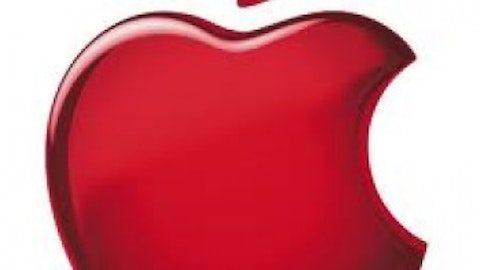
However, over a longer time horizon of around 10 years, long-term International Business Machines Corp. (NYSE:IBM) shareholders must be quite happy, as IBM has still delivered a total return of more than 160%, beating S&P 500’s total return of only 74%. Should investors consider the recent dip as a buying opportunity? Let’s find out.
Technology services and software bring the most business
International Business Machines Corp. (NYSE:IBM) has a long history dating back to 1911, when it was known as the Computing-Tabulating-Recording Company. The company is considered one of the biggest information technology companies in the world, operating in five main segments — Global Technology Services, Global Business Services, Software, Systems and Technology, and Global Financing.
Most of its revenue, $40.24 billion, or 38.7% of total 2012 revenue, was generated from the Global Technology Services segment while the Software segment ranked second, with $25.45 billion in revenue in 2012. However, as the Software segment contributed the highest pre-tax income of $28.7 billion with an operating margin of 37.6%, Global Technology Services contributed nearly $7 billion in operating income.
Sluggish first quarter performance
The reason why International Business Machines Corp. (NYSE:IBM) shares dropped was due to the sluggish performance in the first quarter of 2013. IBM experienced a decline in both revenue and pre-tax income compared to the first quarter last year. While revenue decreased 5.1% to $23.4 billion, its pre-tax income dropped 6% to only $3.6 billion.
However, because of the lower provision for income taxes and lower total outstanding shares, its EPS actually reached $2.70 per share, 3.4% higher than the EPS in the first quarter of 2012. It is the first time that IBM has missed analysts’ estimates since 2005. Its non-GAAP EPS came in at $3 per share, lower than Wall Street’s expectation of $3.05.
International Business Machines Corp. (NYSE:IBM) uses quite some leverage in its operations. As of March 2013, it had $19 billion in total stockholders’ equity, $10.6 billion in cash, and $24.7 billion in long-term debt. In addition, the company recorded as much as $19 billion in retirement and non-pension post-retirement benefit obligations. At $190 per share, International Business Machines Corp. (NYSE:IBM) is worth $211.6 billion on the market. The market values IBM at around 8.75 times EV/EBITDA.
Intel Corporation (NASDAQ:INTC) also had a declining first quarter
Intel Corporation (NASDAQ:INTC), one of the biggest chipmakers in the world, also reported lower Q1 2013 revenue and net income compared to the first quarter 2012. Revenue decreased from $12.9 billion in Q1 2012 to $12.58 billion in Q1 2013, while net income dropped from $2.74 billion, or $0.53 per share, to $2 billion, or $0.40 per share.
Intel Corporation (NASDAQ:INTC) is significantly affected by the overall weakness in the global PC industry. Its PC Client Group’s revenue witnessed an year-over-year decline of 6% to around $8 billion, which accounted for 63.6% of total revenue.
In terms of balance sheet, Intel Corporation (NASDAQ:INTC) has a much stronger balance sheet than IBM. As of March 2013, it had $51.2 billion in total stockholders’ equity, $10 billion in cash and short-term investments, and only $13.1 billion in long-term debt. In addition, it has nearly $4.7 billion in marketable equity securities and $1.3 billion in other long-term investments.
At around $22.40 per share, Intel Corporation (NASDAQ:INTC) is worth around $111 billion on the market. The market values Intel quite cheaply at only 5.1 times EV/EBITDA. Income investors might like Intel a lot due to its high dividend yield of 4% while IBM offers investors dividend a yield of only 1.8%.
Microsoft Corporation (NASDAQ:MSFT) – cheap and nice dividend yield
If investors are looking for other tech giants which are paying decent dividends and are valued cheaply, they should consider . Many investors might think that Microsoft Corporation (NASDAQ:MSFT) gets hit hard by the declining global PC sales.
However, most of Microsoft Corporation (NASDAQ:MSFT)’s revenue and income, $24 billion and $15.7 billion, respectively, comes from the Microsoft Business Division, including Microsoft Dynamics business solutions and the Microsoft Office system. What is more encouraging for Microsoft is Microsoft Business Division’s income has risen steadily to $15.7 billion in 2012.
Microsoft Corporation (NASDAQ:MSFT) also has a very strong balance sheet. As of March 2013, it had nearly $76.7 billion in equity, $85.7 billion in cash and investments, and only $14.2 billion in debt. Microsoft Corporation (NASDAQ:MSFT) is trading around $32 per share, with a total market cap of $271 billion. The market values Microsoft quite cheaply at only 6.7 times EV/EBITDA. Income investors might also like Microsoft with its decent dividend yield at 2.9%.
My Foolish take
All three companies — International Business Machines Corp. (NYSE:IBM), Intel Corporation (NASDAQ:INTC) and Microsoft Corporation (NASDAQ:MSFT), could fit well in investors’ long-term income portfolios. Even with the highest valuation among the three, IBM seems to be the most decent pick for the long run because most of its business comes from software and technology services.
The weakness in the PC industry does not affect IBM much. Furthermore, Warren Buffett also likes IBM a lot. IBM has become the third biggest position, accounting for as much as 17.3% of his total portfolio at the end of 2012.
The article A Sluggish Quarter for Warren Buffett’s Most Favorite Tech Giant originally appeared on Fool.com and is written by Anh Hoang.
Copyright © 1995 – 2013 The Motley Fool, LLC. All rights reserved. The Motley Fool has a disclosure policy.
